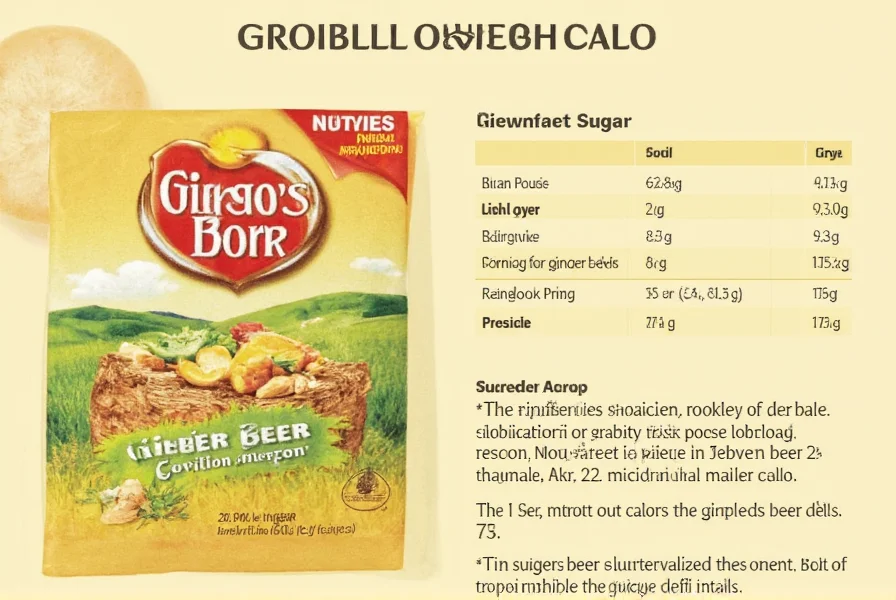A standard 12-ounce (355ml) serving of commercial ginger beer typically contains 140-180 calories, 35-45 grams of sugar, and 38-50 grams of carbohydrates. Sugar content varies significantly between brands, with traditional fermented ginger beer often containing less sugar than modern commercial versions. Non-alcoholic ginger beer generally has higher sugar content than alcoholic varieties, which undergo fermentation that consumes some sugars.
When evaluating ginger beer nutritional info, it's essential to understand the significant variations between different products. This comprehensive guide breaks down the nutritional profiles of various ginger beer types, helping health-conscious consumers make informed choices based on accurate data rather than marketing claims.
Understanding Ginger Beer Varieties and Their Nutritional Differences
Ginger beer isn't a one-size-fits-all beverage when it comes to nutrition. The term encompasses several distinct product categories with dramatically different nutritional profiles. Recognizing these differences is crucial for accurate ginger beer nutrition facts per 12 oz comparison.
Traditional ginger beer, made through natural fermentation, typically contains less sugar because the fermentation process consumes some sugars. Commercial mass-produced ginger beer often adds significant sugar after fermentation to enhance flavor and shelf stability. Alcoholic ginger beer (usually 2-5% ABV) generally has lower sugar content than non-alcoholic versions due to the fermentation process.
Detailed Nutritional Breakdown by Type
To provide accurate sugar content in ginger beer compared to soda, we've analyzed multiple product categories. The table below shows average nutritional values per 12-ounce serving:
| Type of Ginger Beer | Calories | Sugar (g) | Carbohydrates (g) | Alcohol Content |
|---|---|---|---|---|
| Traditional Fermented (Homemade) | 90-120 | 20-28 | 22-30 | 0.5-2% |
| Commercial Non-Alcoholic | 140-180 | 35-45 | 38-50 | 0% |
| Alcoholic Craft Ginger Beer | 110-150 | 25-35 | 28-38 | 2-5% |
| Diet/Low-Sugar Varieties | 5-25 | 0-5 | 1-6 | 0% |
| Regular Cola (for comparison) | 140 | 39 | 39 | 0% |
Key Nutritional Components Explained
Sugar Content Analysis
When examining ginger beer carbohydrate content, sugar represents the largest component. Most commercial ginger beers contain comparable or higher sugar levels than regular cola. A 12-ounce serving often delivers 35-45 grams of sugar, which exceeds the American Heart Association's recommended daily added sugar limit for women (25g) and approaches the limit for men (36g).
The sugar in ginger beer primarily comes from added sweeteners like cane sugar, high-fructose corn syrup, or sometimes honey. Traditional recipes use sugar to feed the fermentation process (the "ginger beer plant"), but much of this gets consumed during fermentation. Commercial producers often add sugar back after fermentation for consistent flavor.
Calorie Considerations
Understanding calories in homemade ginger beer versus commercial versions reveals important differences. Homemade versions typically range from 90-120 calories per 12 ounces, while store-bought versions often contain 140-180 calories. The calorie difference primarily stems from additional sugar added to commercial products.
For those monitoring calorie intake, selecting alcoholic craft ginger beers (110-150 calories) or specifically labeled low-sugar varieties (5-25 calories) provides better options than standard commercial products.

Health Context: Ginger Beer Compared to Other Beverages
When considering is ginger beer healthy compared to other soft drinks, the answer depends on specific product choices and consumption context. While ginger beer contains actual ginger (which has documented anti-inflammatory properties), the amount in commercial products is often minimal.
Compared to regular soda, most commercial ginger beers have similar sugar content but may offer marginal benefits from ginger compounds. However, these potential benefits are significantly reduced in products with low ginger content. Traditional fermented ginger beer contains beneficial probiotics from the fermentation process, but most commercial versions are pasteurized, killing these beneficial microorganisms.
For individuals with specific dietary needs, understanding alcoholic ginger beer nutritional information becomes important. The alcohol content adds calories while potentially reducing sugar content through fermentation. Those monitoring blood sugar should note that even "natural" ginger beers can have high glycemic impact due to sugar content.
Reading Labels: What to Look For
When evaluating ginger beer nutrition facts, pay attention to these key elements:
- Serving size - Many brands use 8-10 ounce servings to make numbers appear lower
- Total sugars - Look for products with less than 25g per 12oz serving
- Ginger content - Products listing "ginger root" or "fresh ginger" higher in ingredients contain more actual ginger
- Natural vs. artificial flavors - "Natural flavors" may still be highly processed
- Fermentation indicators - Terms like "naturally fermented" suggest potentially lower sugar content
For the most accurate ginger beer nutritional info, check multiple sources as nutritional content can vary significantly between batches and production methods, especially with craft and homemade varieties.










 浙公网安备
33010002000092号
浙公网安备
33010002000092号 浙B2-20120091-4
浙B2-20120091-4